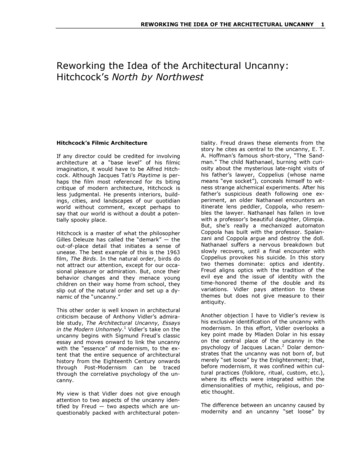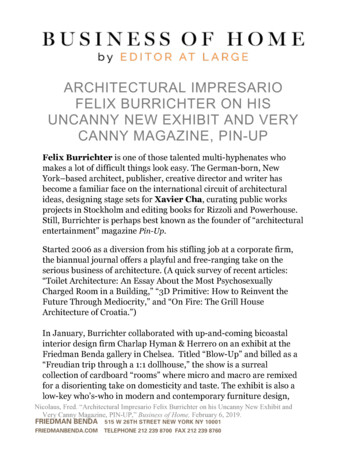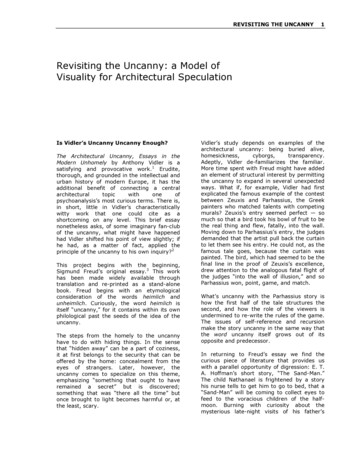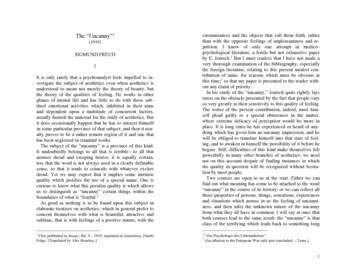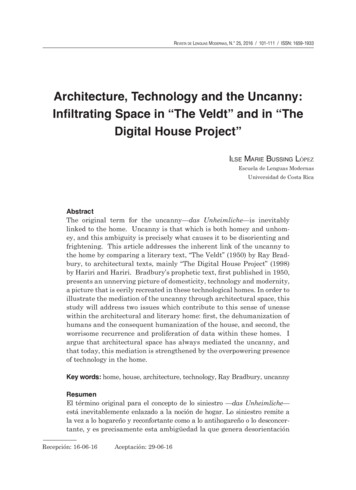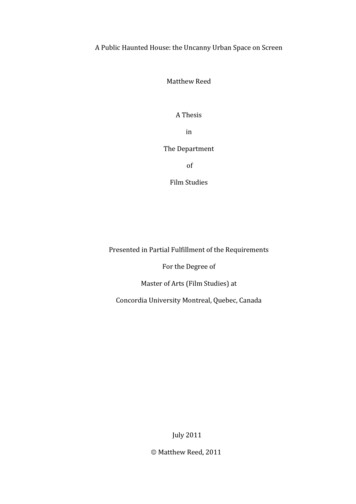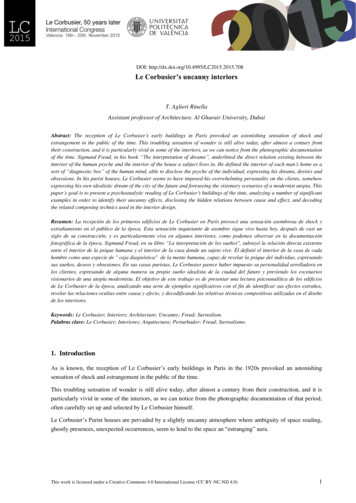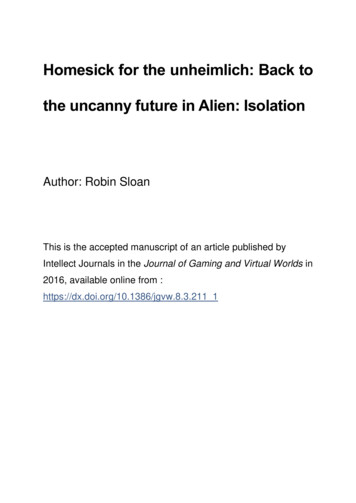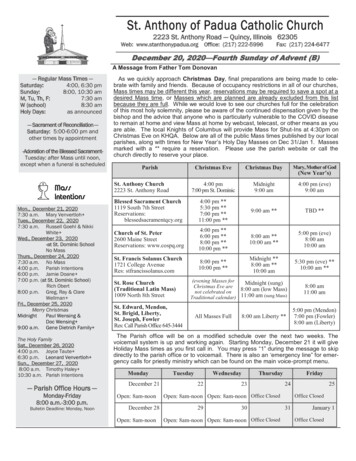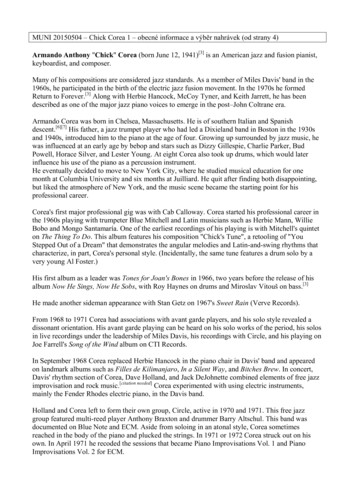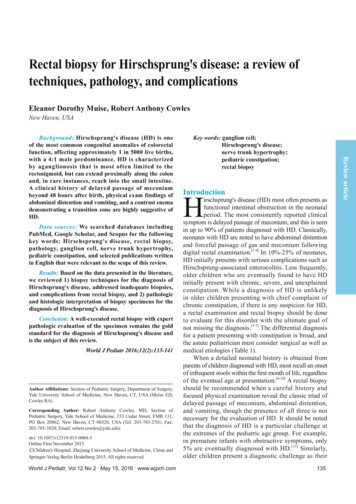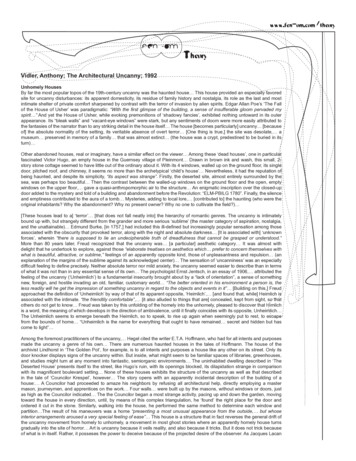
Transcription
Vidler, Anthony; The Architectural Uncanny; 1992Unhomely HousesBy far the most popular topos of the 19th-century uncanny was the haunted house This house provided an especially favoredsite for uncanny disturbances: its apparent domesticity, its residue of family history and nostalgia, its role as the last and mostintimate shelter of private comfort sharpened by contrast with the terror of invasion by alien spirits. Edgar Allan Poe’s ‘The Fallof the House of Usher’ was paradigmatic: “With the first glimpse of the building, a sense of insufferable gloom pervaded myspirit ” And yet the House of Usher, while evoking premonitions of ‘shadowy fancies’, exhibited nothing untoward in its outerappearance. Its “bleak walls” and “vacant-eye windows” were stark, but any sentiments of doom were more easily attributed tothe fantasies of the narrator than to any striking detail in the house itself The house [becomes particularly] uncanny [becauseof] the absolute normality of the setting, its veritable absence of overt terror [One thing is true,] the site was desolate, amuseum preserved in memory of a family that was almost extinct (the house was a crypt, predestined to be buried in itsturn) Other abandoned houses, real or imaginary, have a similar effect on the viewer Among these ‘dead houses’, one in particularfascinated Victor Hugo, an empty house in the Guernsey village of Pleinmont Drawn in brown ink and wash, this small, 2story stone cottage seemed to have little out of the ordinary about it. With its 4 windows, walled up on the ground floor, its singledoor, pitched roof, and chimney, it seems no more than the archetypical ‘child’s house’ Nevertheless, it had the reputation ofbeing haunted, and despite its simplicity, “its aspect was strange”. Firstly, the deserted site, almost entirely surrounded by thesea, was perhaps too beautiful Then the contrast between the walled-up windows on the ground floor and the open, emptywindows on the upper floor, gave a quasi-anthropomorphic air to the structure An enigmatic inscription over the closed-updoor added to the mystery and told of a building and abandonment before the Revolution: “ELM-PBILG 1780”. Finally, the silenceand emptiness contributed to the aura of a tomb Mysteries, adding to local lore, [contributed to] the haunting (who were theoriginal inhabitants? Why the abandonment? Why no present owner? Why no one to cultivate the field?) [These houses lead to a] ‘terror’ [that does not fall neatly into] the hierarchy of romantic genres. The uncanny is intimatelybound up with, but strangely different from the grander and more serious ‘sublime’ (the master category of aspiration, nostalgia,and the unattainable) Edmund Burke, [in 1757,] had included this ill-defined but increasingly popular sensation among thoseassociated with the obscurity that provoked terror, along with the night and absolute darkness [It is associated with] ‘unknownforces’, wherein “there is supposed to lie an undecipherable truth of dreadfulness that cannot be grasped or understood.”More than 80 years later, Freud recognized that the uncanny was [a particular] aesthetic category It was almost withdelight that he undertook to explore, against those “elaborate treatises on aesthetics which prefer to concern themselves withwhat is beautiful, attractive, or sublime,” feelings of an apparently opposite kind, those of unpleasantness and repulsion (anexplanation of the margins of the sublime against its acknowledged center) The sensation of ‘uncanniness’ was an especiallydifficult feeling to define precisely. Neither absolute terror nor mild anxiety, the uncanny seemed easier to describe than in termsof what it was not than in any essential sense of its own The psychologist Ernst Jentsch, in an essay of 1906, attributed thefeeling of the uncanny (‘Unheimlich’) to a fundamental insecurity brought about by a “lack of orientation”, a sense of somethingnew, foreign, and hostile invading an old, familiar, customary world “The better oriented in his environment a person is, theless readily will he get the impression of something uncanny in regard to the objects and events in it” [Building on this,] Freudapproached the definition of ‘Unheimlich’ by way of that of its apparent opposite, ‘Heimlich’, [and found that, while] Heimlich isassociated with the intimate. “the friendlily comfortable”, [it also alluded to things that are] concealed, kept from sight, so thatothers do not get to know Freud was taken by this unfolding of the homely into the unhomely, pleased to discover that Himlichis a word, the meaning of which develops in the direction of ambivalence, until it finally coincides with its opposite, Unheimlich The Unheimlich seems to emerge beneath the Heimlich, so to speak, to rise up again when seemingly put to rest, to escapefrom the bounds of home “Unheimlich is the name for everything that ought to have remained secret and hidden but hascome to light” Among the foremost practitioners of the uncanny, Hegel cited the writer E.T.A. Hoffmann, who had for all intents and purposesmade the uncanny a genre of his own There are numerous haunted houses in the tales of Hoffmann. The house of thearchivist Lindhorst in ‘The Golden Pot’, for example, is to all intents and purposes a house like any other on its street. Only itsdoor knocker displays signs of the uncanny within. But inside, what might seem to be familiar spaces of libraries, greenhouses,and studies might turn at any moment into fantastic, semiorganic environments The uninhabited dwelling described in ‘TheDeserted House’ presents itself to the street, like Hugo’s ruin, with its openings blocked, its dilapidation strange in comparisonwith its magnificent boulevard setting None of these houses exhibits the structure of the uncanny as well as that describedin the tale of ‘Councilor Krespel’, however The story opens with an apparently incidental description of the building of ahouse: A Councilor had proceeded to amaze his neighbors by refusing all architectural help, directly employing a mastermason, journeymen, and apprentices on the work Four walls were built up by the masons, without windows or doors, justas high as the Councilor indicated The the Councilor began a most strange activity, pacing up and down the garden, movingtoward the house in every direction, until, by means of this complex triangulation, he ‘found’ the right place for the door andordered it cut in the stone. Similarly, walking into the house, he performed the same method to determine each window andpartition The result of his maneuvers was a home “presenting a most unusual appearance from the outside, but whoseinterior arrangements aroused a very special feeling of ease” This house is a structure that in fact reverses the general drift ofthe uncanny movement from homely to unhomely, a movement in most ghost stories where an apparently homely house turnsgradually into the site of horror Art is uncanny because it veils reality, and also because it tricks. But it does not trick becauseof what is in itself. Rather, it posseses the power to deceive because of the projected desire of the observer. As Jacques Lacan
has noted, when the painter Parrhasios triumphed over Zeuxis by depicting a veil on the wall, so lifelike that Zeuxis observed: “Well, now showus what you have painted behind it”, what was at stake was the ‘relation’ between the gaze and the observer, full of desire to possess, and the trickof the painting (the sinister relation between the double, which is both mask and presentation, and the evil, voracious eye, which demands to bedeceived by itself). No wonder then that Councilor Krespel repressed the power of his eye, deliberately forcing himself to be shortsighted (he didnot, like normal men, see something and then point to it, but rather ran toward something and then touched it) Only by so doing could he fabricatea house that was not an evil ‘double’, a willed projection of his worst passions, but that was, rather, a house that contained his inner self, whole anduntroubled, within Thomas de Quincey, an adept in the art of evoking dreams of terror, sometimes with the artificial help of opium, adumbrated the first romanticmeditation on what might be called the spatial uncanny, one no longer entirely dependent on the temporal dislocations of suppression and return, orthe invisible slippages between a sense of the homely and the unhomely, but displayed in the abyssal repetitions of the imaginary void. The verticallabyrinth traced by de Quincey images the artist, Piranesi, caught in a vertigo of his own making, forever climbing unfinished stairs in a labyrinth ofcarceral spaces The endless drive to repeat is uncanny, both for its association with the death drive and by virtue of the ‘doubling’ inherent in theincessant movement without movement Charles Nodier, [in his] ‘Piranèse’ (1836), [expands this to distinguish] the general space of the sublime (height, depth, and extension) fromthat of the uncanny (silence, solitude, internal confinement, that mental space where temporality and spatiality collapse) The passage fromhomely to unhomely, now operating wholly in the mind, reinforces the ambiguity between real world and dream, real world and spirit world, so as toundermine even the sense of security demanded by professional dreamers Buried Alive Another familiar trope of the uncanny: the uncovering of what had been long buried Of all sites, that of Pompeii seemed to many writers toexhibit the conditions of unhomeliness to the most extreme degree. This was a result of its literal ‘burial alive’, but also of its peculiarly distinctcharacter as a ‘domestic’ city of houses and shops (the pleasures of Pompeii, in comparison with those of Rome, were, all visitors agreed,dependent on its homely nature) And yet, despite the evident domesticity of the ruins, they were not by any account homely. For behinf the quotidiansemblance there lurked a horror, equally present to view: skeletons abounded In the literary and artistic uncanny of the 19th century (l’étrange,l’inquiétant, das Unheimliche), all found their natural place in stories that centered on the idea of history suspended Pompeii possessed a levelof archaeological verisimilitude matched by historical drama that made it the perfect vehicle for l’idéal rétrospectif, a retrospective vision thatmerged past and present Pompeii evidently qualified as a textbook example of the uncanny on every level, from the implicit horror of the domesticto the revelations of mysteries that might better have remained unrevealed The brilliance of the light and the transparency of the air wereopposed to the somber tint of the black volcanic sand, the clouds of black dust underfoot, and the omnipresent ashes. Vesuvius itself was depictedas benign as Montmartre, in defiance of his terrifying reputation. The juxtaposition of the modern railway station and antique city; the happiness ofthe tourists in the street of tombs; the ‘banal phrases’ of the guide as he recited the terrible deaths of the citizens in front of their remains On a purely aesthetic level, too, Pompeii seemed to reflect precisely the struggle between the dark mysteries of the first religions and the sublimetransparency of the Homeric hymns For what the first excavations of Pompeii had revealed was a version of antiquity entirely at odds with thesublime The paintings, sculptures, and religious artifacts of the city of Greek foundation were far from the Neoplatonic forms of neoclassicalimagination. Fauns, cupids, satyrs, priapi, centaurs, and prostitutes of every sex replaced the Apollonian grace and Laocoönian strength Themysteries of Isis and a host of Egyptian cults took the place of high philosophy and acropolitan rituals (thus Pompeii betrayed not only the highsublime but a slowly and carefully constructed world of modern mythology) The tombs in Pompeii, city of the dead, were rarely the subjects of necropolitan meditations. To some, indeed, they were positively pleasant Visitors experienced “a light curiosity and a joyous fullness in existence” in this pagan cemetery, conscious of the fact that in these tombs, “inplace of a horrible cadaver” were only ashes Such pleasure in the face of a ritualized death contrasted with the terror felt at the untimely death ofthe inhabitants under the eruption If the uncanny stems, as Freud argues, from the recurrence of a previously repressed emotional effect, transformed by repression into anxiety, thenfear of live burial would constitute a primary example of “this class of frightening things” Here the desire to return to the womb is displaced intothe fear of being buried alive The impossible desire to return to the womb, the ultimate goal represented by nostalgia, would constitute a true‘homesickness’ HomesicknessIn Walter Pater’s fragment ‘The Child in the House’, the dream of Florian parades as the very essence of remembered homeliness [Although]repetition tends to undermine itself by positive assertiveness, the remembered attributed of Florian’s childhood house confirm [the homelyoriginal] (its trees, garden, walls, doors, hearths, windows, furnishings, even its scent contributing to make it the very type of ‘home’) The domesticnostalgia of memory was, for Pater, only the private locus of a deeply felt nostalgia at the passing of history itself. In the last essay of his collection‘The Renaissance’, Pater evokes the haunting figure of Winckelmann in the 19th century (a figure whose discourse of antiquity formed the classicalimaginary for Goethe and Hegel as for Pater himself) Pater lends all of the faintness and remoteness (that the classical has come to have inthe last quarter of the 19th century) to the interpretation of this first Hellenist; he draws a picture of a wandering and unfortunate spirit, born out ofhis rightful place and time, dedicated to the resuscitation of a distant culture Against the ‘color’ of moderni
Vidler, Anthony; The Architectural Uncanny; 1992 Unhomely Houses By far the most popular topos of the 19th-century uncanny was the haunted house This house provided an especially favored site for uncanny disturbances: its apparent domesticity, its residue of
